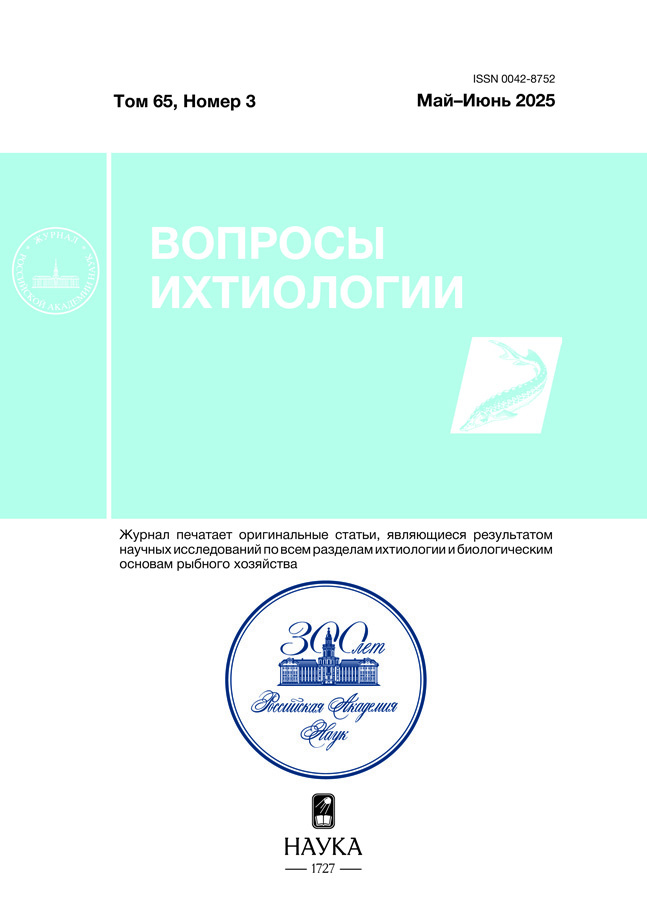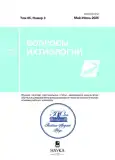On pelagic fishes captured in oceanic waters of the northern part of the Central Atlantic Ocean in autumn 2019 (results of the 44–45th research cruises of the r/v Akademik Nikolaj Strakhov)
- Authors: Shakhovskoy I.B.1, Malikova D.Y.1
-
Affiliations:
- Shirshov Institute of Oceanology, Russian Academy of Sciences
- Issue: Vol 65, No 3 (2025)
- Pages: 328-342
- Section: Articles
- URL: https://rjsvd.com/0042-8752/article/view/688139
- DOI: https://doi.org/10.31857/S0042875225030068
- EDN: https://elibrary.ru/FGNWUC
- ID: 688139
Cite item
Abstract
Data on catches in open waters of the northern tropical part of the Central Atlantic are presented for 16 species of fish from eight families. New findings of the flying fishes Cheilopogon furcatus, C. nigricans and Prognichthys occidentalis, halfbeaks Oxyporhamphus micropterus similis and Hemiramphus balao in the study area allow us to somewhat update current ideas about the distribution of these species. Our collections show a sharp dominance in numbers of four-winged flying fishes (subfamily Cypselurinae) over two-winged flying fish (subfamily Exocoetinae), which dominated the study area in previous years. In addition, within the subfamily Cypselurinae, the nerito–oceanic species Hirundichthys affinis, C. nigricans and P. occidentalis, which were previously absent or rare in the study area, began to quantitatively predominate over the oceanic species H. speculiger, C. exsiliens and P. glaphyrae. We attribute all these changes to invasion of large quantities of sargasso seaweeds (genus Sargassum) in the study area, which apparently facilitated colonization of open ocean waters by previously rare species. Large quantities of sargasso weeds may also lead in the future to the increasingly frequent appearance in the open waters of the tropical Atlantic of coastal species characteristic of flotsam, such as Lobotes surinamensis, Caranx crysos and H. balao.
Full Text
About the authors
I. B. Shakhovskoy
Shirshov Institute of Oceanology, Russian Academy of Sciences
Author for correspondence.
Email: ilisha@yandex.ru
Russian Federation, Moscow
D. Yu. Malikova
Shirshov Institute of Oceanology, Russian Academy of Sciences
Email: ilisha@yandex.ru
Russian Federation, Moscow
References
- Баширова Л.Д., Сивков В.В., Кулешова Л.А. и др. 2020. Комплексные океанологические исследования в 44-м рейсе научно-исследовательского судна “Академик Николай Страхов” в восточной тропической Атлантике // Океанология. Т. 60. № 4. С. 654–656. https://doi.org/10.31857/S0030157420040024
- Иванова Е.В., Сколотнев С.Г., Борисов Д.Г. и др. 2020. Комплексные исследования зон трансформных разломов Долдрамс и Вима в 45-м рейсе научно-исследовательского судна “Академик Николай Страхов” // Там же. Т. 60. № 3. С. 488–490. https://doi.org/10.31857/S0030157420030028
- Парин Н.В. 1963. Результаты изучения пелагической ихтиофауны Тихого и Индийского океанов при помощи электрического света // Тр. ИО АН СССР. Т. 62. С. 128–144.
- Парин Н.В. 1988. Рыбы открытого океана. М.: Наука, 272 с.
- Парин Н.В. 1999. Летучие рыбы рода Prognichthys (Exocoetidae) в Атлантическом океане // Вопр. ихтиологии. Т. 39. № 3. С. 293–305.
- Парин Н.В., Белянина Т.Н. 1996. Географическое распространение и личиночно-мальковые стадии летучих рыб подрода Procypselurus (род Cheilopogon, Exocoetidae) в Атлантическом океане // Там же. Т. 36. № 6. С. 753–761.
- Парин Н.В., Белянина Т.Н. 1998. Возрастная и географическая изменчивость и распространение летучей рыбы Cheilopogon furcatus (Exocoetidae, Beloniformes) с описанием двух новых подвидов // Там же. Т. 38. № 5. С. 581–597.
- Федоряко Б.И. 1989. Сравнительная характеристика ихтиоценов океанского плавника // Там же. Т. 29. № 2. С. 229–238.
- Щербачёв Ю.Н. 1973. Биология и распространение корифен (Pisces, Coryphaenidae) // Там же. Т. 13. Вып. 2. С. 219–230.
- Bruun A.F. 1935. Flying-fishes (Exocoetidae) of the Atlantic: systematic and biological studies // Dana Rep. V. 6. 108 p.
- Carpenter K.E. 2002. Lobotidae. Tripetails // The living marine resources of the Western Central Atlantic. V. 3. Bony fishes. Pt. 2 (Opistognathidae to Molidae), sea turtles and marine mammals. FAO species identification guide for fishery purposes and American society of ichthyologists and herpetologists special publication. № 5. Rome: FAO. P. 1505.
- Carpenter K.E. 2016. Lobotidae. Tripletails // The living marine resources of the Eastern Central Atlantic. V. 4: Bony fishes Pt. 2 (Perciformes to Tetradontiformes) and sea turtles. FAO species identification guide for fishery purposes. Rome: FAO. P. 2544–2545.
- Carvalho-Filho A. 2023. Fishes of the Brazilian coast. São Paulo: Literare Books International, 423 p.
- Collette B.B. 1965. Hemiramphidae (Pisces, Synentognathi) from tropical West Africa // Atlantide Rep. V. 8. P. 217–235.
- Collette B.B. 2016a. Coryphaenidae. Dolphinfishes, “dolphins” // The living marine resources of the Eastern Central Atlantic. V. 4. Bony fishes. Pt. 2 (Perciformes to Tetradontiformes) and sea turtles. FAO species identification guide for fishery purposes. Rome: FAO. P. 2450–2453.
- Collette B.B. 2016b. Echeneidae. Remoras, sharksuckers, discfishes // Ibid. P. 2441–2447.
- Collette B.B. 2016c. Hemiramphidae. Halfbeaks // The living marine resources of the Eastern Central Atlantic. V. 3. Bony fishes. Pt. 1 (Elopiformes to Scorpaeniformes). FAO species identification guide for fishery purposes. Rome: FAO. P. 2156–2162.
- Collette B.B., Bemis K.E. 2019. Family Hemiramphidae. Halfbeaks // Fishes of the Western North Atlantic. Pt. 10. Order Beloniformes: needlefishes, sauries, halfbeaks and flyingfishes. New Haven: Yale Univ. Press. P. 89–147.
- Davenport J. 1994. How and why do flying fish fly? // Rev. Fish Biol. Fish. V. 4. № 2. P. 184–214. https://doi.org/10.1007/BF00044128
- Espino F., Falcón J.M., Otero-Ferrer F. et al. 2018. New data on the occurrence of the tripletail, Lobotes surinamensis (Bloch, 1790) (Actinopterygii: Lobotidae) in the Canary Islands waters // Rev. Acad. Canar. Cienc. V. 30. № 1. P. 57–66.
- Gibbs R.H., Staiger J.C. 1970. Eastern tropical Atlantic flyingfishes of the genus Cypselurus (Exocoetidae) // Stud. Trop. Oceanogr. Miami. № 4. Pt. 2. P. 432–466.
- Hanel R., John H.-C. 2015. A revised checklist of Cape Verde Islands sea fishes // J. Appl. Ichthyol. V. 31. № 1. P. 135–169. https://doi.org/10.1111/jai.12621
- Hubbs C.L. 1933. Observations on the flight of fishes, with a statistical study of the flight of the Cypselurinae and remarks on the evolution of the flight of fishes // Pap. Michigan Acad. Sci. Arts Lett. V. 17. P. 575–611.
- Johns E.M., Lumpkin R., Putman N.F. et al. 2020. The establishment of a pelagic Sargassum population in the tropical Atlantic: biological consequences of a basin-scale long distance dispersal event // Prog. Oceanogr. V. 182. Article 102269. https://doi.org/10.1016/j.pocean.2020.102269
- Oxenford H.A., Johnson D., Cox S.-A., Franks J. 2019. Report on the relationships between Sargassum events, oceanic variables, and dolphinfish and flyingfish fisheries. Cave Hill, Barbados: Univ. West Indies, 32 p.
- Parin N.V., Nakamura I. 2016. Gempylidae. Snake mackerels, escolars and oilfishes // The living marine resources of the Eastern Central Atlantic. V. 4. Bony fishes. Pt. 2 (Perciformes to Tetradontiformes) and sea turtles. FAO species identification guide for fishery purposes. Rome: FAO. P. 2873–2884.
- Parin N.V., Shakhovskoy I.B. 2000. A review of the flying fish genus Exocoetus (Exocoetidae) with descriptions of two new species from the southern Pacific Ocean // J. Ichthyol. V. 40. Suppl. 1. P. S31–S63.
- Sazima I., Grossman A., Carvalho-Filho A., Sazima C. 2009. First record of the tripletail or blackfish (Lobotes surinamensis) from an oceanic island in the South Atlantic // Mar. Biodivers. Rec. V. 2. Article e97. https://doi.org/10.1017/S1755267209001195
- Shakhovskoy I.B. 2018. Specific features of distribution in the World Ocean of some flying fishes of the genera Exocoetus, Hirundichthys and Cypselurus (Exocoetidae) // FishTaxa. V. 3. № 4. P. 40–80.
- Shakhovskoy I.B. 2023. Quantitative distribution of the flying fish (Exocoetidae), marine mammals, birds, and sea turtles in the northern part of the Central Atlantic Ocean (results obtained in the research cruises nos. 43–45 of the R/V “Akademik Nikolaj Strakhov”) // J. Ichthyol. V. 63. № 3. P. 435–468. https://doi.org/10.1134/S0032945223030141
- Shakhovskoy I.B., Parin N.V. 2019. A review of the flying fish genus Cypselurus (Beloniformes: Exocoetidae). Part 1. Revision of the subgenus Zonocypselurus Parin and Bogorodsky, 2011 with descriptions of one new subgenus, four new species and two new subspecies and reinstatement of one species as valid // Zootaxa. V. 4589. № 1. 71 p. https://doi.org/10.11646/zootaxa.4589.1.1
- Skliris N., Marsh R., Addo K.A., Oxenford H. 2022. Physical drivers of pelagic sargassum bloom interannual variability in the Central West Atlantic over 2010–2020 // Ocean Dyn. V. 72. № 6. P. 383–404. https://doi.org/10.1007/s10236-022-01511-1
- Smith-Vaniz W.F. 2016. Carangidae. Jacks, crevalles, scads, bumpers, runners, pompanos, leerfish, vadigo, amber jacks, pilot fishes // The living marine resources of the Eastern Central Atlantic. V. 4. Bony fishes. Pt. 2 (Perciformes to Tetradontiformes) and sea turtles. FAO species identification guide for fishery purposes. Rome: FAO. P. 2454–2514.
- Soto J.M.R. 2001. Peixes do Arquipélago Fernando de Noronha // Mare Magnum. V. 1. № 2. P. 147–169.
- Wang M., Hu C., Barnes B.B. et al. 2019. The great Atlantic Sargassum belt // Science. V. 365. № 6448. P. 83–87. https://doi.org/10.1126/science.aaw7912
- Weber S.B., Richardson A.R., Brown J. et al. 2021. Direct evidence of a prey depletion “halo” surrounding a pelagic predator colony // Proc. Nat. Acad. Sci. V. 118. № 28. Article e2101325118. https://doi.org/10.1073/pnas.2101325118
Supplementary files

















